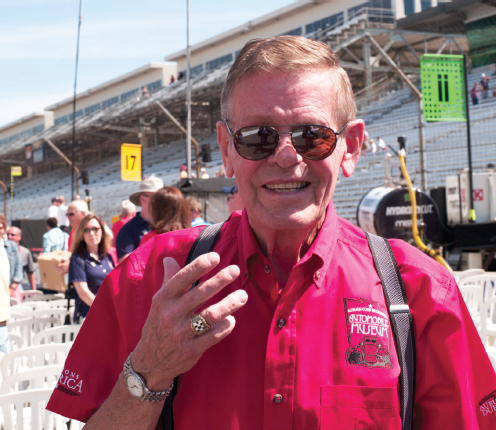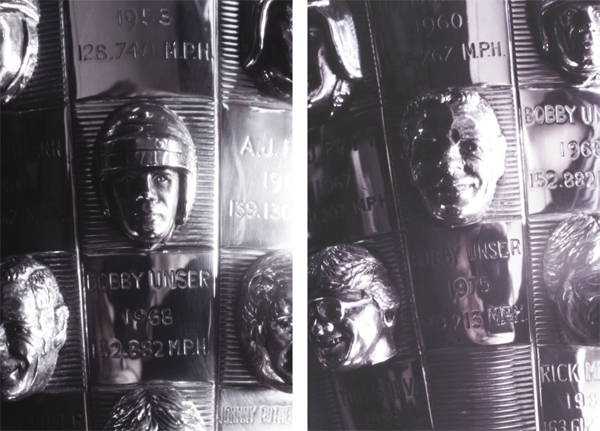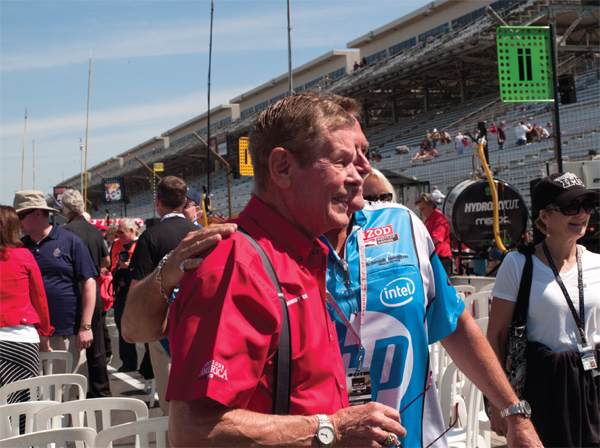
20
BOBBY UNSER

Won Indy 1968, 1975, 1981
Date of interview: February 2004

Bobby Unser proudly shows off one of his championship checkered flag rings.
PEOPLE HATE technology; they really just want to see a contest between human beings. It’s a fan-based sport. It doesn’t make its money by just corporate [backing]; it’s [from] fans [too]. Therefore, if you don’t write about the people that make it you’re not going to have anybody read your stuff.
ON THE CRAFT OF RACING:
Drivers are all a little bit different. Some of them have to psych themselves up to go fast. But I would like to think that the drivers that I knew didn’t have to do that. They really liked to go fast. The guys that I thought were the best drivers . . . the best drivers that I ever ran against . . . were the ones that truly liked motor racing. They really like to drive race cars. You have a lot that don’t really feel that way—they like the money, they like the girls, the excitement, the glory . . . they like all that kind of stuff, all those things that they don’t get in ordinary life. But a real race driver, a true race driver, really races because he likes it. Money isn’t the most important thing, but success is. Have a contest with the other drivers. You can also be friends with them. In my era of racing I had a lot of good friends that were the finest race drivers that I ever knew. Yet on the racetrack it was bitter, bitter, bitter to go against each other as hard as you could. It became an out-and-out outright contest. Man against man. You knew the guy’s habits—all of his habits. You really got into your racing.
It’s a little bit different today. I’m not saying that the drivers that make it today aren’t good. The ones that make it to the top today are good; in fact, they are extremely good. There’s just no question about it. But if you take the drivers back in our era—my brother, A. J. Foyt, Johnny Rutherford, Mario Andretti (there’s so many of them), Don Branson, Roger McCluskey, Lloyd Ruby—those guys were so good it’s unbelievable. Yet they could make their living not from corporations, not from sponsors, but from their earnings from driving race cars, winning, or placing in a race. And that’s the total income that they had. Yeah, they did a little PR work and anything they could do, but most of them did very little. So they truly, truly, truly loved to go to a race. They liked it when the green flag fell. Most of these drivers I’m talking about couldn’t race often enough. Sometimes these guys (myself included) would race four times a week. That wasn’t enough. In fact, I used to lay in bed and dream or wish there was a way that I could run seven nights a week. I truly loved the sport. I liked driving race cars. It was a challenge. It didn’t make any difference . . . I never tried to think about making money. I knew I had to make money, but I never let that be the decision. Now some drivers have been more successful than others in the money department and yet good race drivers. Like Andretti—Mario was money-hungry but a helluva race driver. But that’s okay. I’m not knocking him. My hat’s off to him. I’m glad he made a lot of money; I did fairly well myself. Al did very fairly well, as did Foyt and Parnelli. Think about the guys that did it. They did it because they turn the steering wheel, not because of some corporation that used them for PR work.
Speed is only relative to what you’re driving and what your talents are. Someone is always faster than the next guy. Not everybody runs at exactly the same speed. It has to do with the car that you have to drive, the owner, the mechanics, the combination, the team. You look at some years—you look at some of Al’s years, for example; in the early 1970s he was untouchable. He broke most of Foyt’s records because he had a really good combination and . . . they kept the team together. Al and George Bignotti made a good team; they had good cars and they had a good crew. Everybody has those years if they become famous. I had my years, and Parnelli, Mario, and Rutherford . . . they all had their years when the combinations were right. I had a lot of good combinations, I had good years with Gurney, and I had super good years with Leader Card Racers. That was Bob Wilkie. When I drove for Wilkie, he was the Roger Penske of those days. When I drove for Gurney, we’re talking about Dan Gurney, we just made a “super team” out of Gurney’s “All American Racers.” He was in the business of making race cars, and I was the factory driver.
Dan is actually the guy that came up with the idea of the “wicker bill.” I’m the guy that developed it. Dan and I were testing his car at Phoenix. Dan said, “I’ve got an idea for something to put on the wing.” He said, “Would you like to try it?” and I said “Sure.” For a workshop he had an open trailer. He went over there and started hammering on a piece of aluminum and pretty soon he comes over and said, “I’ve got it done.” He said, “Let me know when you want to try it” (because I basically ran the test). I said, “Let’s try it right now.” Dan’s a smart guy, always very, very, very good at ideas.
I knew immediately. I didn’t have to do a full lap. I already knew that we had a discovery that was beyond belief, probably the biggest discovery that motor racing has ever had in the history of motor racing. So I pulled in; I ran just a few laps because I knew we had spies around the track (we always do). The tire people—Goodyear and Firestone—were the big-money people in those days. I pulled in, I didn’t act excited or anything, so even the firemen wouldn’t see anything. I got Dan and Wayne Leary, my chief mechanic, and I calmly told them, “Guys, we’ve just made the biggest discovery ever.” Of course, Dan, he doesn’t understand it. He (honest to goodness) did not understand it, because why didn’t I go fast?
Well, I was a very smart race driver. I hid a lot of things for many years.
I told him nonchalantly, “Make me a couple for the front.” So he took what he’d done to the rear, and now Wayne and Dan and I (everybody pitched in), that’s what we’re going to work on. At any rate it was a gigantic thing. I’d say it’s the biggest single change that’s ever happened in motor racing.

Here are two of Bobby’s three images on the Borg-Warner trophy—one with a “helmet” and the other without.

We went to Indianapolis with it and I kept a secret. Ironically, I didn’t know how we were going to hide it . . . ’cause it sticks out like a sore thumb. Dan’s concept was let’s just not hide it, because you can’t hide it. Don’t cover the wings like all these teams do today; keep everything out in the open (he’s selling race cars anyway). Sell ’em up the kazoomie, you know? Don’t hide them; just leave it. Maybe nobody’ll notice ’em. What it looks like was a stabilizer to keep the wing from bending at high speed. With the wind pressing so hard against the wing, it looks like we put a little stabilizer on it to keep it from bending. We used to have the first garage going down the center of Gasoline Alley. I’d stand there and peek behind the curtain because all the cars went by us to go get fuel, on the way to the fuel dump. So I look at all of them going by, the McLarens, all the Eagles we’d sold; nobody copied us—not Rutherford, not Mario, not Foyt, not anybody! So I just can’t believe this. I mean I’ve really, really, really got a big deal. Then I finally saw another Eagle come by. This is a second-class team with no money. They’d bought a new car from Gurney, but they have no engines, no spares, not a good driver, all of that stuff. He rolls by the garage and he’s got it. He copied it, but he’s a real slow car. The car wouldn’t go fast if you painted it with a pink brush and put polka dots on it. That thing’s not going to help him. He’s got no engine. He’s lucky if he makes the race.
In other words, they were just a team that didn’t have financial capabilities. He was the only guy that copied it, probably out of sixty cars.
That was USAC, not the IRL. We didn’t have all the rules that we have now. I didn’t have to explain; I didn’t have to apologize. There wasn’t any violation of the rules. Nobody figured it out. Now the whole world uses it. If I wanted to change the size of this “wicker bill” I’d never do it “out there.” I’d do that back at the garage. But in the beginning nobody copied us. If we had covered it up I’m sure somebody would’ve done it.
OTHER INNOVATIONS:
We once had a turbo charger that was way better than anyone else’s. This is in the same era. Ironically I used to walk past Rutherford’s garage; I could see that he had one just like it sitting there on the shelf underneath the bench. They never put it on the car.
Today they’ve got so many rules. The cars are all basically the same. It’s a “spec” deal. They’ve all got the same equipment. The only difference is in the setup. There’s only three kinds of cars that are allowed; innovation has kind of stopped. But they do that to limit the speed, for safety.
They’ll always have rules, but if they get going too fast it’s the drivers, the mechanics, the car owners, the track owners, all these people get together and they say, “Hey, we’re crashing too many cars. Maybe we should slow ’em down.” Or all the drivers are starting to complain. It doesn’t matter to the fans if you’re doing 200 or 230 if you’re watching the cars. For general safety sake we need to keep the speeds to whatever is reasonable compared to the technology that’s making the speed happen. It’s technology that’s doing it, not the drivers.
Today it’s way safer. Technology never stops. We are a human race. You can’t stop our brain from working. So in order to slow our brains down . . . the “rules makers” keep making rules to prevent technology from benefiting. It just hampers people like myself, who invent technology (speed), to do things that haven’t been tried before. That’s what our job is.
They’ve really slowed technology down, at least in the IRL, not in NASCAR. There is no technology in NASCAR. It’s the same car for thirty years that they’ve built. Don’t get me wrong. I get along really, really well with some of those NASCAR guys, but they’ve got to be careful or they’re going to become a “professional wrestling” kind of deal.
Back in my era IndyCar racing, open-wheel racing, was way more popular. Just when they started having the “wars” [CART vs. the IRL], NASCAR started marketing really heavy: on our side of the street we had “wars.”
You know we’re not making heroes out of the drivers anymore. It’s the cars. In IndyCars the driver is down so low you can’t see him anymore. He’s got “car body” all around him. It’s killing open-wheel racing.
